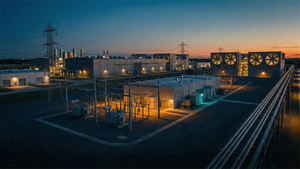
In a dramatic turn of events that sent shockwaves through global financial markets, the once-unassailable rally in artificial intelligence (AI) and Nvidia (NASDAQ: NVDA) stocks experienced a stunning reversal in the days leading up to and culminating on November 20, 2025. This precipitous decline, fueled by growing concerns of an "AI bubble," shifting interest rate expectations, and a dramatic post-earnings intraday reversal from Nvidia, led to a significant tumble for the tech-heavy Nasdaq Composite. The sudden downturn has ignited intense debate among investors and analysts about the sustainability of current AI valuations and the broader economic outlook.
The market's abrupt shift from unbridled optimism to widespread caution marks a pivotal moment for the AI industry. What began as a seemingly unstoppable surge, driven by groundbreaking advancements and unprecedented demand for AI infrastructure, now faces a stark reality check. The recent volatility underscores a collective reassessment of risk, forcing a deeper look into the fundamental drivers of the AI boom and its potential vulnerabilities as macroeconomic headwinds persist and investor sentiment becomes increasingly skittish.
Unpacking the Volatility: A Confluence of Market Forces and AI Valuation Scrutiny
The sharp decline in AI and Nvidia stocks, which saw the Nasdaq Composite fall nearly 5% month-to-date by November 20, 2025, was not a singular event but rather the culmination of several potent market dynamics. At the forefront were pervasive fears of an "AI bubble," with prominent economists and financial experts, including those from the Bank of England and the International Monetary Fund (IMF), drawing parallels to the dot-com era's speculative excesses. JPMorgan Chase (NYSE: JPM) CEO Jamie Dimon notably warned of a potential "serious market correction" within the next six to 24 months, amplifying investor anxiety.
Compounding these bubble concerns was the unprecedented market concentration. The "magnificent seven" technology companies, a group heavily invested in AI, collectively accounted for 20% of the MSCI World Index—a concentration double that observed during the dot-com bubble. Similarly, the five largest companies alone constituted 30% of the S&P 500 (INDEXSP:.INX), the highest concentration in half a century, fueling warnings of overvaluation. A Bank of America (NYSE: BAC) survey revealed that 63% of fund managers believed global equity markets were currently overvalued, indicating a widespread belief that the rally had outpaced fundamentals.
A critical macroeconomic factor contributing to the reversal was the weakening expectation of Federal Reserve interest rate cuts. A stronger-than-expected September jobs report, showing 119,000 new hires, significantly diminished the likelihood of a December rate cut, pushing the odds below 40%. This shift in monetary policy outlook raised concerns that higher borrowing costs would disproportionately suppress the valuations of high-growth technology stocks, which often rely on readily available and cheaper capital. Federal Reserve officials had also expressed hesitation regarding further rate cuts due to persistent inflation and a stable labor market, removing a key support pillar for speculative growth.
The dramatic intraday reversal on November 20, following Nvidia's (NASDAQ: NVDA) third-quarter earnings report, served as a potent catalyst for the broader market tumble. Despite Nvidia reporting blockbuster earnings that surpassed Wall Street's expectations and issuing an optimistic fourth-quarter sales forecast, initial investor enthusiasm quickly evaporated. After an early surge of 5%, Nvidia's stock flipped to a loss of more than 1.5% by day's end, with the S&P 500 plunging 2.5% in minutes. This swift turnaround, despite positive earnings, highlighted renewed concerns about stretched AI valuations and the diminished prospects of Federal Reserve support, indicating that even stellar performance might not be enough to justify current premiums without favorable macroeconomic conditions.
Shifting Sands: Implications for AI Companies, Tech Giants, and Startups
The recent market volatility has significant implications for a wide spectrum of companies within the AI ecosystem, from established tech giants to burgeoning startups. Companies heavily reliant on investor funding for research and development, particularly those in the pre-revenue or early-revenue stages, face a tougher fundraising environment. With a collective "risk-off" sentiment gripping the market, investors are likely to become more discerning, prioritizing profitability and clear pathways to return on investment over speculative growth. This could lead to a consolidation phase, where well-capitalized players acquire smaller, struggling startups, or where less differentiated ventures simply fade away.
For major AI labs and tech giants, including the "magnificent seven" like Alphabet (NASDAQ: GOOGL), Microsoft (NASDAQ: MSFT), Amazon (NASDAQ: AMZN), and Apple (NASDAQ: AAPL), the impact is multifaceted. While their diversified business models offer some insulation against a pure AI stock correction, their valuations are still closely tied to AI's growth narrative. Nvidia (NASDAQ: NVDA), as the undisputed leader in AI hardware, directly felt the brunt of the reversal. Its stock's sharp decline, despite strong earnings, signals that even market leaders are not immune to broader market sentiment and valuation concerns. The competitive landscape could intensify as companies double down on demonstrating tangible AI ROI to maintain investor confidence.
The potential disruption extends to existing products and services across industries. Companies that have heavily invested in integrating AI, but have yet to see significant returns, might face increased pressure to justify these expenditures. An August 2025 report by MIT highlighted that despite $30-40 billion in enterprise investment into Generative AI, 95% of organizations were seeing "zero return," a statistic that likely fueled skepticism and contributed to the market's reassessment. This could lead to a more pragmatic approach to AI adoption, with a greater focus on proven use cases and measurable business outcomes rather than speculative integration.
In terms of market positioning and strategic advantages, companies with strong balance sheets, diverse revenue streams, and a clear, demonstrable path to profitability from their AI initiatives stand to weather this storm more effectively. Those that can articulate how AI directly contributes to cost savings, efficiency gains, or new revenue generation will be better positioned to attract and retain investor confidence. This period of correction might ultimately strengthen the market by weeding out overhyped ventures and rewarding those with solid fundamentals and sustainable business models.
A Broader Lens: AI's Place in a Skeptical Market Landscape
The stunning reversal in AI and Nvidia stocks is more than just a blip; it represents a critical inflection point in the broader AI landscape, signaling a shift from unbridled enthusiasm to a more cautious and scrutinizing market. This event fits squarely into a trend of increasing skepticism about the immediate, tangible returns from massive AI investments, especially following reports like MIT's, which indicated a significant gap between enterprise spending on Generative AI and actual realized value. The market is now demanding proof of concept and profitability, moving beyond the initial hype cycle.
The impacts of this correction are wide-ranging. Beyond the immediate financial losses, it could temper the pace of speculative investment in nascent AI technologies, potentially slowing down the emergence of new, unproven startups. On the positive side, it might force a healthier maturation of the industry, pushing companies to focus on sustainable business models and real-world applications rather than purely speculative valuations. Potential concerns include a "chilling effect" on innovation if funding dries up for high-risk, high-reward research, though established players with robust R&D budgets are likely to continue pushing boundaries.
Comparisons to previous AI milestones and breakthroughs highlight a recurring pattern: periods of intense hype followed by a "AI winter" or a market correction. While the underlying technology and its potential are undeniably transformative, the market's reaction suggests that investor exuberance often outpaces the practical deployment and monetization of these advancements. The current downturn, however, differs from past "winters" in that the foundational AI technology is far more mature and integrated into critical infrastructure, suggesting a correction rather than a complete collapse of interest.
This market event also underscores the intertwined relationship between technological innovation and macroeconomic conditions. The weakening expectations for Federal Reserve rate cuts and broader global economic uncertainty acted as significant headwinds, demonstrating that even the most revolutionary technologies are not immune to the gravitational pull of monetary policy and investor risk appetite. The U.S. government shutdown, delaying economic data, further contributed to market uncertainty, illustrating how non-tech factors can profoundly influence tech stock performance.
The Road Ahead: Navigating Challenges and Unlocking Future Potential
Looking ahead, the AI market is poised for a period of recalibration, with both challenges and opportunities on the horizon. Near-term developments will likely focus on companies demonstrating clear pathways to profitability and tangible ROI from their AI investments. This means a shift from simply announcing AI capabilities to showcasing how these capabilities translate into cost efficiencies, new revenue streams, or significant competitive advantages. Investors will be scrutinizing financial reports for evidence of AI's impact on the bottom line, rather than just impressive technological feats.
In the long term, the fundamental demand for AI technologies remains robust. Expected developments include continued advancements in specialized AI models, edge AI computing, and multi-modal AI that can process and understand various types of data simultaneously. Potential applications and use cases on the horizon span across virtually every industry, from personalized medicine and advanced materials science to autonomous systems and hyper-efficient logistics. The current market correction, while painful, may ultimately foster a more resilient and sustainable growth trajectory for these future applications by weeding out unsustainable business models.
However, several challenges need to be addressed. The "AI bubble" fears highlight the need for more transparent valuation metrics and a clearer understanding of the economic impact of AI. Regulatory frameworks around AI ethics, data privacy, and intellectual property will also continue to evolve, potentially influencing development and deployment strategies. Furthermore, the high concentration of market value in a few tech giants raises questions about market fairness and access to cutting-edge AI resources for smaller players.
Experts predict that the market will continue to differentiate between genuine AI innovators with strong fundamentals and those riding purely on hype. Michael Burry's significant bearish bets against Nvidia (NASDAQ: NVDA) and Palantir (NYSE: PLTR), and the subsequent market reaction, serve as a potent reminder of the influence of seasoned investors on market sentiment. The consensus is that while the AI revolution is far from over, the era of easy money and speculative valuations for every AI-adjacent company might be. The next phase will demand greater discipline and a clearer demonstration of value.
The AI Market's Reckoning: A New Chapter for Innovation and Investment
The stunning reversal in AI and Nvidia stocks, culminating in a significant Nasdaq tumble around November 20, 2025, represents a critical reckoning for the artificial intelligence sector. The key takeaway is a definitive shift from an era of speculative enthusiasm to one demanding tangible returns and sustainable business models. The confluence of "AI bubble" fears, market overvaluation, weakening Federal Reserve rate cut expectations, and a dramatic post-earnings reversal from a market leader like Nvidia (NASDAQ: NVDA) created a perfect storm that reset investor expectations.
This development's significance in AI history cannot be overstated. It marks a maturation point, similar to past tech cycles, where the market begins to separate genuine, value-creating innovation from speculative hype. While the underlying technological advancements in AI remain profound and transformative, the financial markets are now signaling a need for greater prudence and a focus on profitability. This period of adjustment, while challenging for some, is ultimately healthy for the long-term sustainability of the AI industry, fostering a more rigorous approach to investment and development.
Looking ahead, the long-term impact will likely be a more robust and resilient AI ecosystem. Companies that can demonstrate clear ROI, efficient capital allocation, and a strong competitive moat built on real-world applications of AI will thrive. Those that cannot adapt to this new, more discerning market environment will struggle. The focus will shift from "what AI can do" to "what AI is doing to generate value."
In the coming weeks and months, investors and industry watchers should closely monitor several key indicators. Watch for continued commentary from central banks regarding interest rate policy, as this will heavily influence the cost of capital for growth companies. Observe how AI companies articulate their path to profitability and whether enterprise adoption of AI begins to show more concrete returns. Finally, keep an eye on valuation metrics across the AI sector; a sustained period of rationalization could pave the way for a healthier, more sustainable growth phase in the years to come.
This content is intended for informational purposes only and represents analysis of current AI developments.
TokenRing AI delivers enterprise-grade solutions for multi-agent AI workflow orchestration, AI-powered development tools, and seamless remote collaboration platforms.
For more information, visit https://www.tokenring.ai/.




